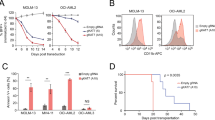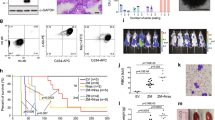Abstract
The recurrent translocation t(8;16)(p11 ;p13) is a cytogenetic hallmark for the M4/M5 subtype of acute myeloid leukaemia. Here we identify the breakpoint-associated genes. Positional cloning on chromosome 16 implicates the CREB-binding protein (CBP), a transcriptional adaptor/coactivator protein. At the chromosome 8 breakpoint we identify a novel gene, MOZ, which encodes a 2,004-amino-acid protein characterized by two C4HC3 zinc fingers and a single C2HC zinc finger in conjunction with a putative acetyltransferase signature. In-frame MOZ–CBP fusion transcripts combine the MOZ finger motifs and putative acetyltransferase domain with a largely intact CBP. We suggest that MOZ may represent a chromatin-associated acetyltransferase, and raise the possibility that a dominant MOZ–CBP fusion protein could mediate leukaemogenesis via aberrant chromatin acetylation.
This is a preview of subscription content, access via your institution
Access options
Subscribe to this journal
Receive 12 print issues and online access
$209.00 per year
only $17.42 per issue
Buy this article
- Purchase on Springer Link
- Instant access to full article PDF
Prices may be subject to local taxes which are calculated during checkout
Similar content being viewed by others
References
Rabbitts, T.H. Chromosomal translocations in human cancer. Nature 372, 143–149 (1994).
Second MIC Cooperative Study Group. Morphologic, immunologic, and cytogenetic working classification of the acute myeloid leukemias. Cancer Genet. Cytogenet. 30, 1–15 (1988).
Hanslip, J.I., Swansbury, G.J., Pinkerton, R. & Catovsky, D. The translocation t (8;16) (p11;p13) defines an AML subtype with distinct cytology and clinical features. Leuk. Lymphoma 6, 479–486 (1992).
Mitelman, F. & Heim, S. Quantitative acute leukemia cytogenetics. Genes Chromosom. Cancer 5, 57–66 (1992).
Stark, B. et al. A distinct subtype of M4/M5 acute myeloblastic leukemia (AML) associated with t (8:16) (p11:p13), in a patient with the variant t (8:19) (p11:q13)-case report and review of the literature. Leuk. Res. 19, 367–379 (1995).
Quesnel, B. et al. Therapy-related acute myeloid leukemia with t (8;21), inv (16), and t (8;16): a report on 25 cases and review of the literature. J. Clin. Oncol. 11, 2370–2379 (1993).
Lai, J.L. et al. Acute monocytic leukemia with t (8;22) (p11;q13) translocation. Involvement of 8p11 as in classical t (8;16) (p11;p13). Cancer Genet. Cytogenet. 60, 180–182 (1992).
Tanzer, J. et al. La leucémie aiguë à translocation (8;16). Nouv. Rev. Fr. Hematol. 30, 83–87 (1988).
Inhorn, R.C. et al. A syndrome of lymphoblastic lymphoma, eosinophilia, and myeloid hyperplasia/malignancy associated with t (8;13) (p11;q11): description of a distinctive clinicopathologic entity. Blood 7, 1881–1887 (1995).
Bellomo, M.J., Mÿhlematter, D., Wicht, M., Delacréz, F. & Schmidt, P.M. t (8;9) (p11 ;q32) in atypical chronic myeloid leukemia: a new cytogenetic-clinicopathologic association? Br. J. Haematol. 81, 307–309 (1992).
Wessels, J.W. et al. Two distinct loci on the short arm of chromosome 16 are involved in myeloid leukemia. Blood 77, 1555–1559 (1991).
Rubinstein, J.H. & Taybi, H. Broad thumbs and toes and facial abnormalities: a possible mental retardation syndrome. Am. J. Dis. Child. 105, 588–608 (1963).
Miller, R.W. & Rubinstein, J.H. Tumors in Rubinstein-Taybi syndrome. Am. J. Med. Genet. 56, 112–115 (1995).
Petrij, F. et al. Rubinstein-Taybi syndrome caused by mutations in the transcriptional co-activator CBP. Nature 376, 348–351 (1995).
Chrivia, J.C. et al. Phosphorylated CREB binds specifically to the nuclear protein CBP. Nature 365, 855–859 (1993).
Kwok, R.P.S. et al. Nuclear protein CBP is a coactivator for the transcription factor CREB. Nature 370, 223–226 (1994).
Arias, J. et al. Activation of cAMP and mitogen responsive genes relies on a common nuclear factor. Nature 370, 226–229 (1994).
Kamei, Y. et al. A CBP integrator complex mediates transcriptional activation and AP-1 inhibition by nuclear receptors. Cell 85, 403–414 (1996).
Eckner, R. et al. Molecular cloning and functional analysis of the adenoviral E1A-associated 300-kD protein (p300) reveals a protein with properties of a transcriptional adaptor. Genes Dev. 8, 869–884 (1994).
Lundblad, J.R., Kwok, R.P.S., Laurence, M.E., Harter, M.L. & Goodman, R.H., E1A-associated protein p300 as a functional homologue of the transcriptional co-activator CBP. Nature 374, 85–88 (1995).
Tanaka, S., Matsushita, Y. & Isono, K. Cloning and molecular characterization of the gene rimL which encodes an enzyme acetylating ribosomal protein L12 of Escherichia coli K12. Mol. Gen. Genet. 217, 289–293 (1989).
Tercero, J.C., Riles, L.E. & Wickner, R.B. Localized mutagenesis and evidence for post-transcriptional regulation of MAK3. J. Biol. Chem. 267, 20270–20276 (1992).
Kleff, S., Andrulis, E.D., Anderson, C.W. & Sternglanz, R. Identification of a gene encoding a yeast histone H4 acetyltransferase. J. Biol. Chem. 270, 24674–24677 (1995).
Aasland, R., Gibson, T.J. & Steward, A.F. The PHD finger: implications for chromatin-mediated transcriptional regulation. Trends Blochem. Sci. 20, 56–59 (1995).
Koken, M.H., Saib, A. & de Thé, H. A C4HC3 zinc finger motif. C. R. Acad. Sci. III 318, 733–739 (1995).
Saha, V., Chaplin, T., Gregorini, A., Ayton, P. & Young, B.D. The leukemia-associated-protein (LAP) domain, a cysteine-rich motif, is present in a wide range of proteins, including MLL, AF10, and MLLT6 proteins. Proc. Natl. Acad. Sci. USA 92, 9737–9741 (1995).
Loidl, P. Histone acetylation: facts and questions. Chromosoma 103, 441–149 (1994).
Himmelbauer, H. et al. Saturating the region of the polycystic kidney disease gene with Noti linking clones. Am. J. Hum. Genet. 48, 325–334 (1991).
Church, D.M. et al. Isolation of genes from complex sources of mammalian genomic DNA using exon amplification. Nature Genet. 6, 98–105 (1994).
Altschul, S.F., Gish, W., Miller, W., Myers, E.W. & Lipman, D.J. Basic local alignment search tool. J. Mol. Biol. 215, 403–410 (1990).
Wydner, K.L., Bhattacharya, S., Eckner, R., Lawrence, J.B. & Livingstone, D.M. Localization of human CREB-binding protein gene (CREBBP) to 16p13. 2-p13.3 by fluorescence in situ hybridization. Genomics 30, 395–396 (1995).
Hudson, T.J. et al. An STS-based map of the human genome. Science 270, 1945–1954 (1995).
Dib, A. et al. Characterization of the region of the short arm of chromosome 8 amplified in breast carcinoma. Oncogene 10, 995–1001 (1995).
Robbins, J., Dilworth, S.M., Laskey, R.A. & Dingwall, C. Two interdependent basic domains in nucleoplasmin nuclear targeting sequence: identification of a class of bipartite nuclear targeting sequence. Cell 64, 615–623 (1991).
Gabig, T.G., Mantel, P.L., Rosil, R. & Crean, C.D. Requiem: a novel zinc finger gene essential for apoptosis in myeloid cells. J. Biol. Chem. 269, 29515–29519 (1994).
Buchman, V.L. et al. Differential splicing creates a diversity of transcripts from a neurospecific developmentally regulated gene encoding a protein with new zinc-finger motifs. Nucleic Acids Res. 20, 5579–5585 (1992).
Scherens, B., Bakkoury, M.E., Vierendeels, F., Dubois, E. & Messenguy, F. Sequencing and functional analysis of a 32560-bp segment on the left arm of yeast chromosome II. Identification of 26 open reading frames, including the KIPI and SEC17 genes. Yeasts 9, 1355–1371 (1993).
Kamine, J., Elangovan, B., Subramanian, T., Coleman, D. & Chinnadurai, G. Identification of a cellular protein that specifically interacts with the essential cysteine region of the HIV-1 Tat transactivator. Virology 216, 357–366 (1996).
Georgakopoulos, T. & Thireos, G. Two distinct yeast transcriptional activators require the function of the GCN5 protein to promote normal levels of transcription. EMBO J. 11, 4145–4152 (1992).
Brownell, J.E. et al. Tetrahymena histone acetyltransferase A: a homolog to yeast GcnSp linking histone acetylation to gene activation. Cell 84, 843–851 (1996).
Lennon, G.G., Auffray, C., Poiymeropoulos, M. & Scares, M.B. The I.M.A.G.E. Consortium: an integrated molecular analysis of genomes and their expression. Genomics 33, 151–152 (1996).
Arany, Z., Newsome, D., Oldread, E., Livingstome, D.M. & Eckner, R. A family of transcriptional adaptor proteins targeted by the E1A oncoprotein. Nature 374, 81–84 (1995).
Ruiz I. Altaba, A., Perry-O'keefe, H. & Melton, D.A. Xfin: an embryonic gene encoding a multifingered protein in Xenopus. EMBO Journal 6, 3065–3070 (1987).
Morishita, K. et al. Retroviral activation of a novel gene encoding a zinc finger protein in IL-3-dependent myeloid leukemia cell lines. Cell 54, 831–840 (1988).
Baldarelli, R.M. et al. Transcripts of the Drosophila blastoderm-specific locus, terminus, are concentrated posteriorly and encode a potential DNA-binding finger. Dev. Biol. 125, 85–95 (1988).
Dingwall, C. et al. Nucleoplasmin cDNA sequence reveals polyglutamic acid tracts and a cluster of sequences homologous to putative nuclear localization signals. EMBO J. 6, 69–74 (1987).
Mitchell, P.J. & Tjian, R. Transcriptional regulation in mammalian cells by sequence-specific DNA binding proteins. Science 245, 371–378 (1989).
Tamkun, J.W. et al. brahma: a regulator of Drosophila homeotic genes structurally related to the yeast transcriptional activator SNF2/SWI2. Cell 68, 561–572 (1992).
Jeppesen, P. & Turner, B.M. The inactive X chromosome in female mammals is distinguished by a lack of histone H4 acetylation, a cytogenetic marker for gene expression. Cell 74, 281–289 (1993).
Reifsnyder, C., Lowell, J., Clarke, A. & Pillus, P., Yeast SAS silencing genes and human genes associated with AML and HIV-1 Tat interactions are homologous with acetyltransferases. Nature Genet. 14, 42–49 (1996).
Rine, J. & Herskowitz, I. Four genes responsible for a position effect on expression from HML and HMR in Saccnaromyces cerevisiae . Genetics 116, 9–22 (1987).
Megee, P.C., Morgan, B.A., Mittman, B.A. & Smith, M.M. Genetic analysis of histone H4: essential role of lysines subject to reversible acetylation. Science 247, 841–845 (1990).
Braunstein, M., Rose, A.B., Holmes, S.G., Allis, C.D. & Broach, J.R. Transcriptional silencing in yeast is associated with reduced nucleosome acetylation. Genes Dev. 7, 592–604 (1993).
Lee, F.-J.S., Lin, L.-W. & Smith, J.A. Nα-acetyiation is required for normal growth and mating of Saccharomyces cerevisiae. J. Bacteriol. 171, 5795–5802 (1989).
Mullen, J.R. et al. Identification and characterization of genes and mutants for an N-terminal acetyltransferase from yeast. EMBO J. 8, 2067–2075 (1989).
Aparicio, O.M., Billington, B.L. & Gottschling, D.E. Modifiers of position effect are shared between telomeric and silent mating-type loci in S. cerevisiae . Cell 66, 1279–1287 (1991).
Chirgwin, J.M., Pryzbyla, A.E., MacDonald, R.J. & Rutter, W.J. Isolation of biologically active ribonucleic acid from sources enriched in ribonuclease. Biochemistry 18, 5294–5299 (1979).
Sambrook, J., Fritsch, E.F. & Maniatis, T. Molecular Cloning A Laboratory Manual (Cold Spring Harbor Laboratory Press, 1989).
Liu, J. et al. Large-scale cloning of human chromosome 2-specific yeast artifical chromosomes (YACs) using an interspersed repetitive sequences (IRS)-PCR approach. Genomics 26, 178–191 (1995).
Author information
Authors and Affiliations
Rights and permissions
About this article
Cite this article
Borrow, J., Stanton, V., Andresen, J. et al. The translocation t(8;16)(p11;p13) of acute myeloid leukaemia fuses a putative acetyltransferase to the CREB–binding protein. Nat Genet 14, 33–41 (1996). https://doi.org/10.1038/ng0996-33
Received:
Accepted:
Issue Date:
DOI: https://doi.org/10.1038/ng0996-33
This article is cited by
-
Alzheimer’s Disease-Related Epigenetic Changes: Novel Therapeutic Targets
Molecular Neurobiology (2024)
-
Acetyl-CoA biosynthesis drives resistance to histone acetyltransferase inhibition
Nature Chemical Biology (2023)
-
Identification of a novel KAT6A variant in an infant presenting with facial dysmorphism and developmental delay: a case report and literature review
BMC Medical Genomics (2021)
-
KAT7 is a genetic vulnerability of acute myeloid leukemias driven by MLL rearrangements
Leukemia (2021)
-
Directional association test reveals high-quality putative cancer driver biomarkers including noncoding RNAs
BMC Medical Genomics (2019)



